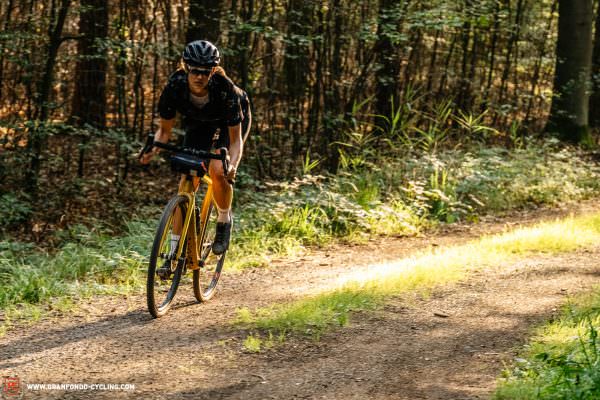With the Santa Cruz Stigmata CC, the US company wants to offer a bike that bridges the gap between cyclocross and gravel. Find out how this mustard yellow race machine fared out on the gravel.
Click here for an overview of the best gravel bike 2020 group test.

For the second generation of the Stigmata CC, the engineering team at Santa Cruz made some careful but significant changes. That means the carbon frameset now has clearance for tires up to 700 x 45C or 650 x 53B, mounts for a third bottle cage and a reworked carbon layup that promises more comfort. The tidy design language, as well as the high-quality finish, make an excellent first impression. Our test bike was equipped with a 1×12 drivetrain consisting of a mix of SRAM Force eTAP AXS shifters, cranks and brakes together with a SRAM X01 Eagle eTap AXS derailleur and 10-50 t cassette. The 440 mm EA70 AX bars and the EA90 aluminium stem along with the zero-offset EC70 seatpost all come from Easton. The 700 x 40C MAXXIS Ravager tires have a pronounced tread and are mounted on Santa Cruz’s own Reserve 22 carbon wheels. As the name suggests, the internal rim width of 22 mm is supposed to offer good support for up to 45 mm tires, while the 24-spoke build is designed to tread the line between comfort and stiffness. Refreshingly, there are no unnecessary nods to aerodynamic performance here, with comparatively shallow rims. The 8.10 kg weight in size 56 is only 20 g higher than that of the lightest bike in our group test, the Trek Domane SLR 9 eTap. In this component spec, the Stigmata CC costs € 6,199.

The Santa Cruz Stigmata C in detail
Drivetrain SRAM Force eTap AXS with SRAM Eagle eTap AXS derailleur
Gearing 42 t and 10-50 t, 1×12
Brakes SRAM Force HRD, 160/160 mm
Handlebar Easton EA70 AX, 440 mm
Stem Easton EA90, 100 mm
Seatpost Easton EC70, 0 mm offset
Wheels Santa Cruz Reserve 22
Tires MAXXIS Ravager 700 x 40C

The brake hose left its mark on the head tube badge. #nogo

The threaded SRAM DUB bottom bracket guarantees easy servicing.

SRAM Force eTap AXS and Eagle eTap AXS components are the gravel dream team.

The Santa Cruz Reserve 22 wheels provide good levels of comfort. The shallow, non-aero rims bring a breath of fresh air that we can only encourage!
| Size | 52 | 54 | 56 | 58 | 60 |
|---|---|---|---|---|---|
| Seat tube | 495 mm | 520 mm | 545 mm | 565 mm | 590 mm |
| Top tube | 526 mm | 545 mm | 565 mm | 572 mm | 591 mm |
| Head tube | 130 mm | 150 mm | 170 mm | 185 mm | 205 mm |
| Head angle | 71.0° | 71.5° | 72.0° | 72.0° | 72.0° |
| Seat angle | 74.5° | 74.0° | 73.5° | 73.5° | 73.5° |
| Chainstays | 425 mm | 425 mm | 425 mm | 425 mm | 425 mm |
| BB Drop | 74 mm | 72 mm | 72 mm | 70 mm | 70 mm |
| Wheelbase | 1,009 mm | 1,015 mm | 1,025 mm | 1,034 mm | 1,053 mm |
| Reach | 372 mm | 380 mm | 388 mm | 392 mm | 405 mm |
| Stack | 555 mm | 576 mm | 596 mm | 609 mm | 628 mm |
The Santa Cruz Stigmata CC in review
The Santa Cruz storms forward when pedalling. While accelerating and going uphill it benefits significantly from its low weight and comparatively low rotating mass. It masters even the steepest ramps despite the 42 t chainring thanks to the massive cassette with its 500 % range. The pronounced profile of the tires is a big advantage on loose terrain but results in relatively high rolling resistance on compacted ground or the road. The riding position is pleasantly compact while the overall comfort level of the bike is good. It’s the mix of compliance from the seatpost and damping stemming from the frameset, tires and wheels that lead to a balanced overall level of comfort. However, what we didn’t like while riding off road was the nervous handling of the Santa Cruz.

Improve your cyclocross skills and head for the mud


CC is denotes Santa Cruz’s highest-quality carbon construction, but it could also be seen as an indicator of the bike’s cyclocross heritage.
The incredibly agile front-end reacts to the smallest inputs, meaning you always have to pay attention. For cyclocross, where you’ll regularly take tight corners at slow speeds that kind of handling is definitely an advantage. However, it’s not quite as well suited to the demands of the gravel sector. The nervous front-end limits how stable the bike feels on the straights and reduces confidence as soon as you pick up speed. You’ll need to be experienced to be able to handle this bike well.

Conclusion
The Santa Cruz Stigmata CC accelerates very quickly with a high level of comfort and compact riding position. Unfortunately, the attempt to bridge the gap between cyclocross courses and gravel tracks is only a limited success. Experienced riders who want a direct handling and agile bike that excels on tight courses will find what they need here. Those looking for a more relaxed ride will find the nervous front-end tiring and will have less confidence in the ride. The Santa Cruz is a cyclocross bike with large tire clearances and far from a gravel all-rounder.
Tops
- balanced comfort
- well-considered component spec
Flops
- very agile front-end
- limited stability
- lack of confidence at high speed
Riding Characteristics
4Agility
- cumbersome
- playful
Stability
- nervous
- confident
Handling
- demanding
- balanced
Fun factor
- boring
- lively
Value for money
- terrible
- very good
For more info: santacruzbicycles.com
Click here for an overview of the best gravel bike 2020 group test.
All bikes in test: Argon 18 Dark Matter | Cannondale Topstone Carbon Ultegra RX | Canyon Grail AL 7.0 | Cervélo Áspero | Giant Revolt Advanced Pro Force | Kona Libre AL | Liteville 4-ONE MK1 | OPEN WI.DE. | Pivot Vault Team Force | ROSE BACKROAD GRX RX810 Di2 | Santa Cruz Stigmata CC | Specialized Turbo Creo SL Expert EVO | Standert Pfadfinder | Trek Domane SLR 9 eTap
No, it’s not about perfect race tracks, it’s about efficiency. Fast, fleet-footed and efficient – those who want to speed along high-speed passages need a defined and spritely bike that accelerates with ease and efficiency. Nevertheless, reliable components are important too. We interpret “Smooth tarmac” bikes as follows: Hard efforts at high speeds with a maximum efficient bike on a consistently well-paved road. Effort-joy ratio: 80:30 (not everything has to be 100%!)↩
… also known as bike riding. Broken-up roads in the hinterland, deadlocked gravel roads, loose surfaces – sometimes muddy, sometimes bone-dry. For this, it takes bikes with super all-round, handling and wearing qualities uphill and downhill. Effort-joy ratio: 50:50↩
If you want to use your bike almost every day, you usually do not need an extremely tuned racing machine. Solid components, which are able to cope with the rigours of continuous usage in any kind of weather, are part of the basic equipment. At the same time, the bike should have practicable details: integrated fenders/assembly options, luggage racks/attachment points and a light system or at least the option of installing bike lights. The position on the bike should be rather relaxed, the overall comfort high, so that the Afterwork Ride becomes a cure and not a curse. Effort-joy ratio: 30:70↩
You can find more info about our rating system in this article: Click here! ↩
Did you enjoy this article? If so, we would be stoked if you decide to support us with a monthly contribution. By becoming a supporter of GRAN FONDO, you will help secure a sustainable future for high-quality cycling journalism. Click here to learn more.
Words: Photos: GRAN FONDO-Team







